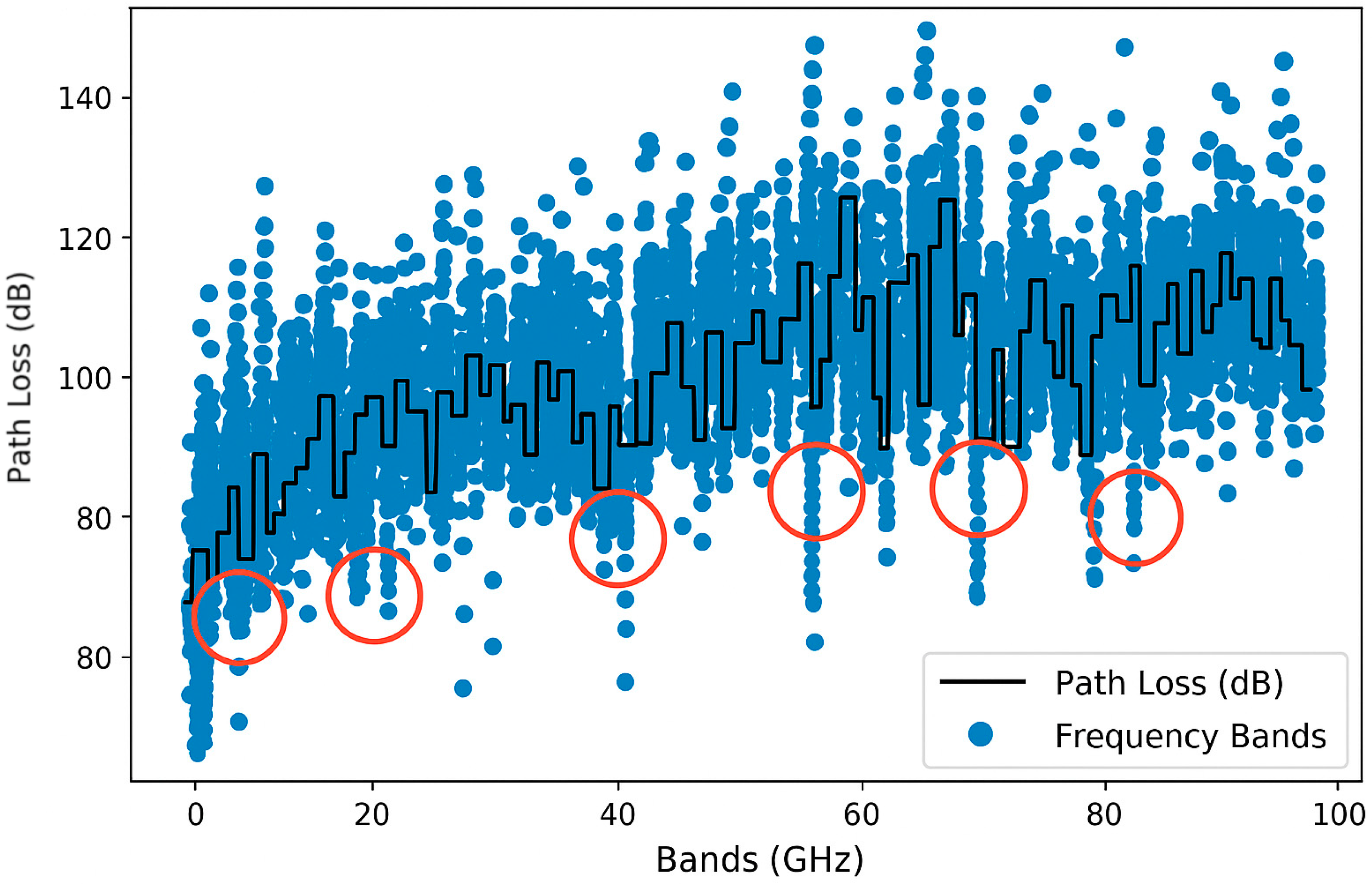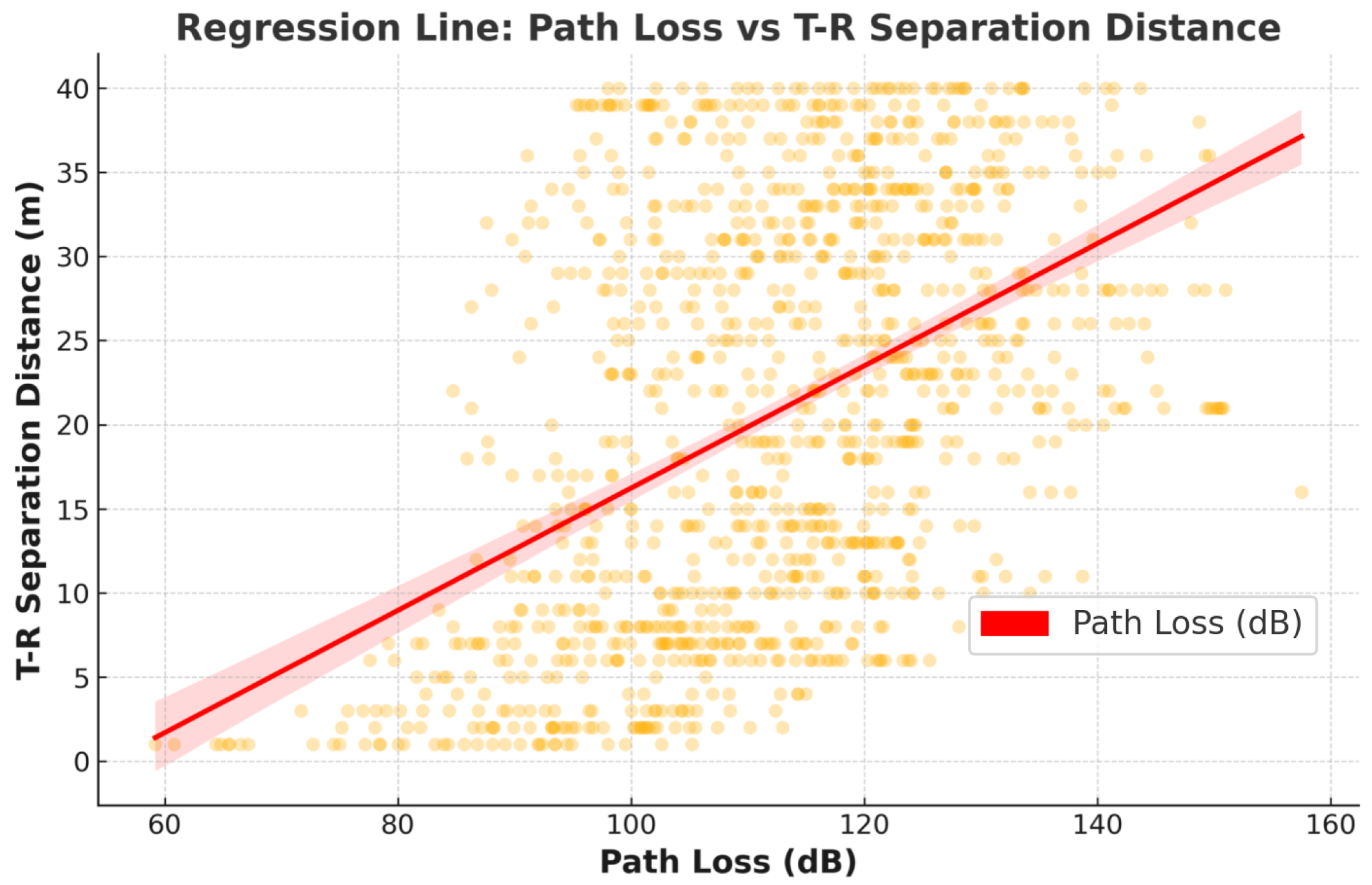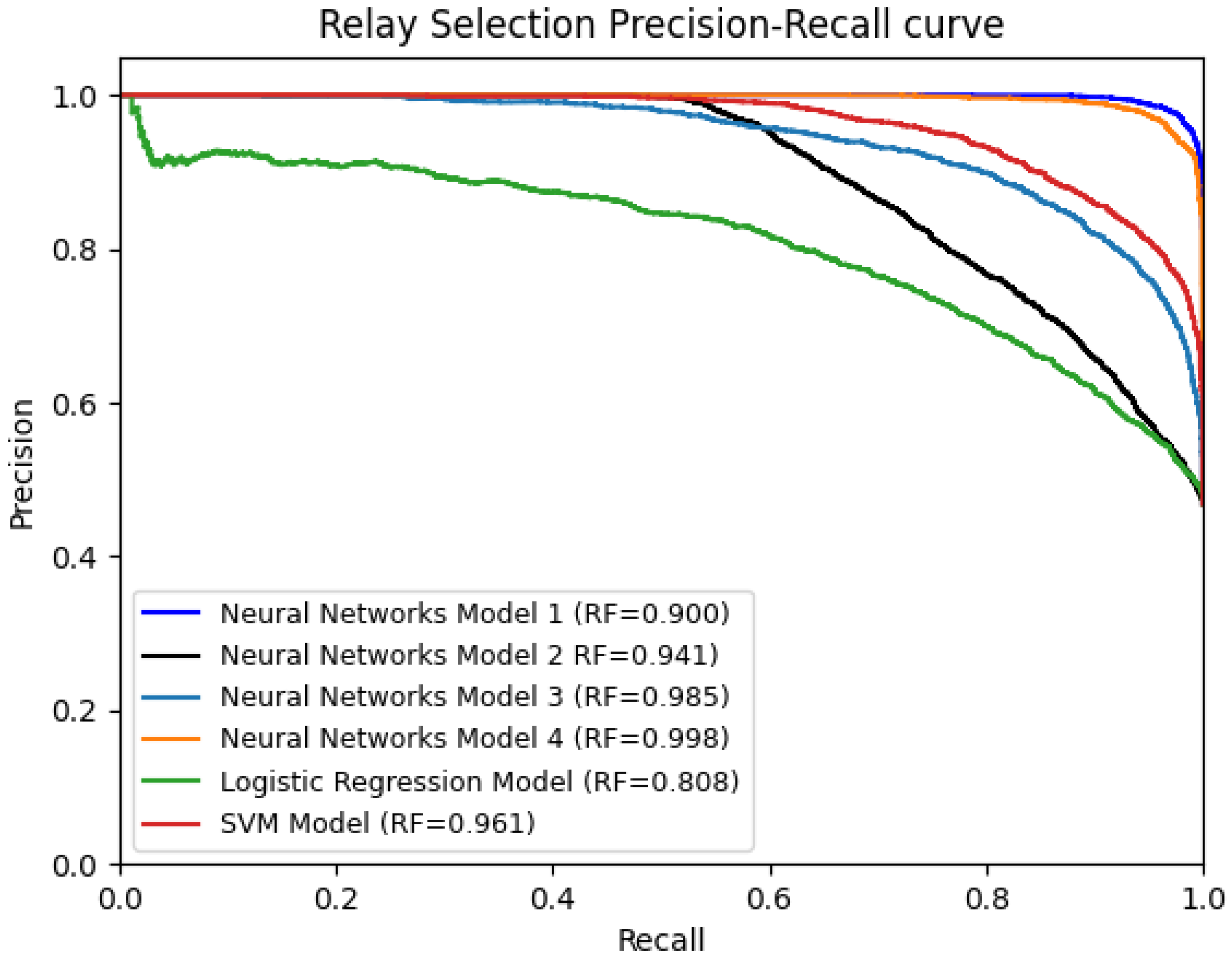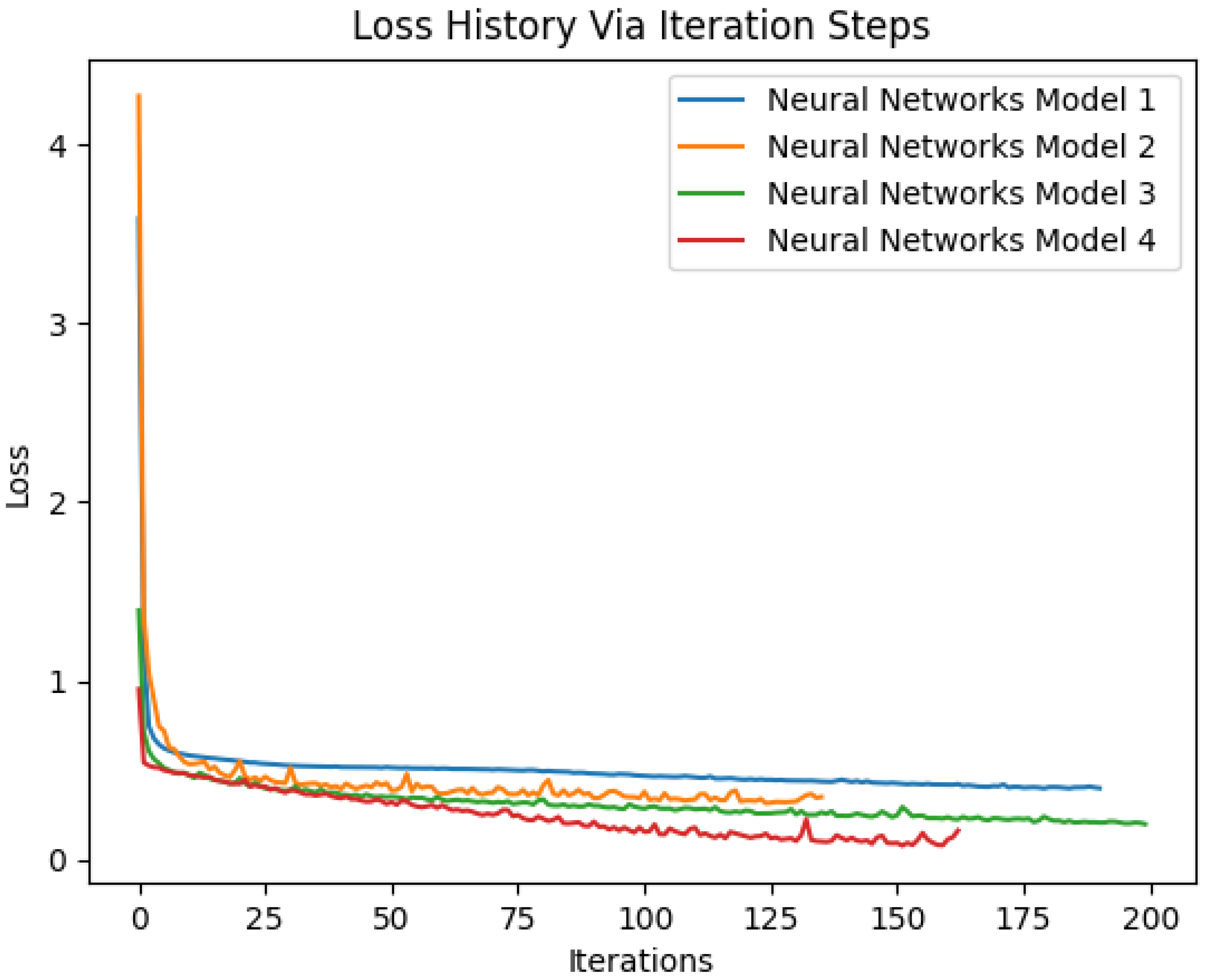Blockage Prediction of an Urban Wireless Channel Characterization Using Classification Artificial Intelligence
Abstract
1. Introduction
- Robust communication: Proactive mitigation of signal degradation, blockage, and channel impairments.
- Enhanced user experience: Consistent high-speed data delivery and reduced latency for users.
- Improved network efficiency: Optimal resource allocation, minimizing wasted bandwidth, and maximizing network capacity.
- Signal Blockage Mitigation: We propose a novel mechanism to enhance signal reception by addressing the inherent susceptibility of mmWave communication to blockage caused by obstacles, ensuring reliable connectivity in dynamic environments.
- AI-Driven Signal Optimization: Leverages artificial intelligence on the reception side by intelligently selecting the optimal signal path or beam, dynamically adapting to changing conditions, and maximizing communication efficiency.
- Enhanced High-Frequency Utilization: Demonstrates methods to optimize high-mmWave frequency bands, overcoming propagation challenges to unlock their potential for reliable communications.
2. Background
3. 6G Radio
3.1. Extensive Machine-to-Machine Interaction
3.2. Network Design for Network Transition Past 5G/6G
4. 6G Challenges and Opportunities
4.1. Material Internet Challenges
4.2. Non-Technical Challenges
4.3. Application Segmentation
5. Knowledge of Artificial Intelligence
5.1. Artificial Intelligence in the Physical Layer
5.2. Artificial Intelligence in Wireless Networks
- Improving the processing capabilities of edge hardware.
- Enhancing coordination between edge and central processing units to optimize task allocation.
5.3. Artificial Intelligence in Network Administration and AI
- Supervised learning: Commonly applied for traffic prediction, classification, and resource forecasting.
- Reinforcement learning: Effective in dynamic resource management and adaptive control.
- Unsupervised learning: Although less common, it offers promising use cases in anomaly detection and traffic pattern discovery.
6. Pervasive Artificial Intelligence Issues
7. Results
- Accuracy: Represents the proportion of correctly classified instances (blocked vs. non-blocked signals). While useful as an overall measure, it can be misleading for imbalanced datasets.
- Precision: Indicates the ability to avoid false positives, which is especially important in identifying blocked signals accurately.
- Recall: Measures the model’s ability to detect blocked signals, minimizing false negatives.
- F1-score: A harmonic mean of precision and recall, used to balance these metrics when they conflict.
- ROC Curve and AUC (Area Under the Curve): Demonstrate the model’s discriminative power across different classification thresholds, with higher AUC values indicating better performance.
7.1. Neural Networks (NNs)
7.1.1. Forward Pass
- is the weight matrix of layer l,
- is the activation from the previous layer,
- is the bias vector of layer l.
7.1.2. Backpropagation
7.1.3. Gradient of the Loss Function
- N is the number of samples,
- is the true label of the i-th sample,
- is the predicted probability for the i-th sample.
7.1.4. Weight and Bias Updates
7.1.5. Propagation to Previous Layers
7.1.6. Parameter Update
7.2. Support Vector Machine
7.3. Logistic Regression
- ○
- Model 1: Shallow network (1 hidden layer, 32 neurons)
- ○
- Model 2: Moderate depth (2 hidden layers, 64–32 neurons)
- ○
- Model 3: Deeper network (3 hidden layers, 128–64–32 neurons)
- ○
- Model 4: Optimized model (4 hidden layers: 128–64–32–16 neurons, with dropout and L2 regularization)Table 1. An assessment of the clustering algorithms.
Classification Algorithm Precision Score Recall Score F1-Score NN Model 1 0.81 0.81 0.80 NN Model 2 0.86 0.85 0.85 NN Model 3 0.98 0.98 0.98 NN Model 4 1.00 0.99 1.00 LG Model 0.80 0.79 0.79 SVM Model 0.96 0.95 0.96
- ○
- Capture Nonlinear Relationships: The path loss and blockage relationship involve complex, nonlinear patterns influenced by environmental factors, which NNs can model effectively.
- ○
- Handle High-Dimensional Data: NNs efficiently process multivariate features such as distance, power, and angle of departure/arrival, leveraging their layered architecture.
- ○
- Achieve Optimization via Backpropagation: The NN used in this study was fine-tuned through hyperparameter optimization, including the number of hidden layers, neurons, and learning rates, allowing it to learn intricate patterns from the data.
- ○
- Enable Scalability: The NN’s architecture was better suited for larger datasets compared to SVM and LR.
- NN Model 4 had more hidden layers, neurons per layer, and a higher learning rate, enabling it to learn complex, nonlinear relationships between features (e.g., path loss, distance, received power).
- These architectural enhancements provided the model with a greater capacity to capture intricate patterns in the dataset.
- NN Model 4 demonstrated the best trade-off between precision and recall, as reflected in its high F1-score.
- This balance indicates that it effectively reduced both false positives and false negatives, making it highly reliable in detecting blockage and non-blockage scenarios.
- Input Layer:
- ○
- 10 neurons (corresponding to 10 input features, including T-R separation distance, received power, azimuth AoD, elevation AoD, path loss, and RMS delay spread).
- Hidden Layers:
- ○
- Layer 1: 128 neurons, Adam activation
- ○
- Layer 2: 64 neurons, Adam activation
- ○
- Layer 3: 32 neurons, ReLU activation
- ○
- Layer 4: 16 neurons, ReLU activation
- Output Layer:
- ○
- 1 neuron, Sigmoid activation (since the task is a binary classification: “blocked” vs. “non-blocked”).
- Optimizer: Adam (Adaptive Moment Estimation)
- Learning Rate: 0.001
- Batch Size: 64
- Loss Function: Binary Cross-Entropy
- Epochs: 100
- Regularization: L2 ( = 0.0001) applied to all layers
- Dropout: 20
7.4. Comparative Analysis with Literature Benchmarks
- Ghassemi et al. (2025) [10]: Introduced a Vision Transformer (ViT)-based dual-band prediction framework using visual context for enhanced robustness, achieving 98.6% accuracy with high computational cost due to transformer complexity.
- Charan et al. (2021) [11]: Developed a vision-aided model combining wireless and visual features to predict blockage and facilitate proactive handover, achieving 96.5% accuracy but requiring visual sensor inputs.
- Alrabeiah et al. (2021) [40] and others proposed hybrid deep learning models integrating sub-6 GHz auxiliary data and high-dimensional feature fusion, achieving 97.2–98.0% accuracy.
7.5. Computational Complexity
| Model | Time Complexity (Training) | Space Complexity | Remarks |
|---|---|---|---|
| Logistic Regression (LR) | Efficient and scalable for linear problems; limited modeling capability for nonlinear patterns. | ||
| Support Vector Machine (SVM) | to | Effective in small to medium-scale problems; kernel computations make it costly for large datasets. | |
| Neural Network (NN Model 4) | High training cost, but scalable and fast at inference; supports GPU acceleration; best suited for complex nonlinear tasks. |
- n = number of training samples
- d = number of input features
- = number of neurons in layer i
- e = number of training epochs
8. Future Work
9. Conclusions
Funding
Data Availability Statement
Conflicts of Interest
References
- Bang, A.; Kamal, K.; Joshi, P.; Bhatia, K. 6G: The next Giant leap for AI and ML. Procedia Comput. Sci. 2023, 218, 310–317. [Google Scholar] [CrossRef]
- Dang, S.; Amin, O.; Shihada, B.; Alouini, M. What should 6G be? Nat. Electron. 2020, 3, 20–29. [Google Scholar] [CrossRef]
- Seidel, S.; Rappaport, T. 914 MHz path loss prediction models for indoor wireless communications in multifloored buildings. IEEE Trans. Antennas Propag. 1992, 40, 207–217. [Google Scholar] [CrossRef]
- Aldossari, S.; Chen, K. Predicting the path loss of wireless channel models using machine learning techniques in mmWave urban communications. In Proceedings of the 22nd International Symposium on Wireless Personal Multimedia Communications (WPMC 2019), Lisbon, Portugal, 24–27 November 2019; pp. 1–6. [Google Scholar] [CrossRef]
- Sun, S.; MacCartney, G.; Rappaport, T. A novel millimeter-wave channel simulator and applications for 5G wireless communications. In Proceedings of the 2017 IEEE International Conference on Communications (ICC), Paris, France, 21–25 May 2017; pp. 1–7. [Google Scholar] [CrossRef]
- 3GPP. Study on Channel Model for Frequencies from 0.5 to 100 GHz (Release 16). 3rd Generation Partnership Project (3GPP), TR 38.901. 2018. Available online: https://www.3gpp.org/ftp/Specs/archive/38_series/38.901/ (accessed on 24 September 2024).
- Moraitis, N.; Nikita, K. Ray-tracing propagation modeling in an urban environment at 140 GHz for 6G wireless networks. IEEE Access 2023, 11, 133835–133849. [Google Scholar] [CrossRef]
- Jiang, H.; Mukherjee, M.; Zhou, J.; Lloret, J. Channel modeling and characteristics for 6G wireless communications. IEEE Netw. 2020, 35, 296–303. [Google Scholar] [CrossRef]
- Serghiou, D.; Khalily, M.; Brown, T.; Tafazolli, R. Terahertz channel propagation phenomena, measurement techniques and modeling for 6G wireless communication applications: A survey, open challenges and future research directions. IEEE Commun. Surv. Tutor. 2022, 24, 1957–1996. [Google Scholar] [CrossRef]
- Ghassemi, M.; Zhang, H.; Afana, A.; Sediq, A.; Erol-Kantarci, M. Generative AI-enabled Blockage Prediction for Robust Dual-Band mmWave Communication. arXiv 2025, arXiv:2501.11763. [Google Scholar]
- Charan, G.; Alrabeiah, M.; Alkhateeb, A. Vision-aided 6G wireless communications: Blockage prediction and proactive handoff. IEEE Trans. Veh. Technol. 2021, 70, 10193–10208. [Google Scholar] [CrossRef]
- Rappaport, T.S.; Xing, Y.; Kanhere, O.; Ju, S.; Madanayake, A.; Mandal, S.; Alwis, C.; Zajic, A. Wireless Communications and Applications Above 100 GHz: Opportunities and Challenges for 6G and Beyond. IEEE Access 2019, 7, 78729–78757. [Google Scholar] [CrossRef]
- Jornet, J.; Akyildiz, I. Channel modeling and capacity analysis for electromagnetic wireless nanonetworks in the terahertz band. IEEE Trans. Wirel. Commun. 2011, 10, 3211–3221. [Google Scholar] [CrossRef]
- Ghosh, A.; Ratasuk, R.; Mondal, B.; Mangalvedhe, N.; Thomas, T. Millimeter-Wave Enhanced Local Area Systems: A High-Data-Rate Approach for Future Wireless Networks. IEEE J. Sel. Areas Commun. 2020, 32, 1152–1163. [Google Scholar] [CrossRef]
- Gapeyenko, M.; Samuylov, A.; Gerasimenko, M.; Moltchanov, D.; Singh, S.; Aryafar, E.; Yeh, S.; Himayat, N.; Andreev, S.; Koucheryavy, Y. Analysis of Human-Body Blockage in Urban Millimeter-Wave Cellular Communications. In Proceedings of the 2016 IEEE International Conference On Communications (ICC), Kuala Lumpur, Malaysia, 22–27 May 2016; pp. 1–7. Available online: https://arxiv.org/abs/1604.04743.
- Letaief, K.; Chen, W.; Shi, Y.; Zhang, J.; Zhang, Y. The Roadmap to 6G: AI Empowered Wireless Networks. IEEE Commun. Mag. 2019, 57, 84–90. [Google Scholar] [CrossRef]
- Ju, S.; Rappaport, T. Millimeter-wave extended NYUSIM channel model for spatial consistency. In Proceedings of the 2018 IEEE Global Communications Conference (GLOBECOM), Abu Dhabi, United Arab Emirates, 10–12 December 2018; pp. 1–6. [Google Scholar]
- Aldossari, S. Predicting Path Loss of an Indoor Environment Using Artificial Intelligence in the 28-GHz Band. Electronics 2023, 12, 497. [Google Scholar] [CrossRef]
- Mohjazi, L.; Selim, B.; Tatipamula, M.; Imran, M.A. The Journey Toward 6G: A Digital and Societal Revolution in the Making. IEEE Internet Things Mag. 2024, 7, 119–128. [Google Scholar] [CrossRef]
- Pons, M.; Valenzuela, E.; Rodrırguez, B.; Nolazco-Flores, J.; Del-Valle-Soto, C. Utilization of 5G technologies in IoT applications: Current limitations by interference and network optimization difficulties—A review. Sensors 2023, 23, 3876. [Google Scholar] [CrossRef]
- Hamad Ameen, J. 5G Mobile System Drawbacks and Limitations. In International Conference On ICT For Sustainable Development; Springer Nature: Singapore, 2023; pp. 21–28. [Google Scholar]
- Brata, M.; Zakia, I. Path Loss Estimation of 5G Millimeter Wave Propagation Channel–Literature Survey. In Proceedings of the 2021 7th International Conference on Wireless And Telematics (ICWT), Bandung, Indonesia, 19–20 August 2021; pp. 1–4. [Google Scholar]
- Braud, T.; Chatzopoulos, D.; Hui, P. Machine type communications in 6G. In 6G Mobile Wireless Networks; Springer International Publishing: Cham, Switzerland, 2021; pp. 207–231. [Google Scholar]
- Aldosary, A.M.; Aldossari, S.A.; Chen, K.-C.; Mohamed, E.M.; Al-Saman, A. Predictive Wireless Channel Modeling of mmWave Bands Using Machine Learning. Electronics 2021, 10, 3114. [Google Scholar] [CrossRef]
- Dogra, A.; Jha, R.; Jain, S. A Survey on Beyond 5G Network With the Advent of 6G: Architecture and Emerging Technologies. IEEE Access 2021, 9, 67512–67547. [Google Scholar] [CrossRef]
- Ariyanti, S.; Suryanegara, M. Visible light communication (VLC) for 6G technology: The potency and research challenges. In Proceedings of the 2020 Fourth World Conference on Smart Trends in Systems, Security And Sustainability (WorldS4), London, UK, 27–28 July 2020; pp. 490–493. [Google Scholar]
- Thota, S.; Govind, T. 6G: Opportunities and challenges. In Towards Wireless Heterogeneity in 6G Networks; CRC Press: Boca Raton, FL, USA, 2024; pp. 1–17. [Google Scholar]
- Luo, X.; Chen, H.; Guo, Q. LEO/VLEO Satellite Communications in 6G and Beyond Networks–Technologies, Applications and Challenges. IEEE Netw. 2024, 38, 273–285. [Google Scholar] [CrossRef]
- Khowaja, S.; Khuwaja, P.; Dev, K.; Lee, I.; Khan, W.; Wang, W.; Qureshi, N.; Magarini, M. A secure data sharing scheme in Community Segmented Vehicular Social Networks for 6G. IEEE Trans. Ind. Inform. 2022, 19, 890–899. [Google Scholar] [CrossRef]
- Nawaz, S.; Sharma, S.; Wyne, S.; Patwary, M.; Asaduzzaman, M. Quantum machine learning for 6g communication networks: State-of-the-art and vision for the future. IEEE Access 2019, 7, 46317–46350. [Google Scholar] [CrossRef]
- Zhang, S.; Zhu, D.; Liu, Y. Artificial intelligence empowered physical layer security for 6G: State-of-the-art, challenges, and opportunities. Comput. Netw. 2024, 242, 110255. [Google Scholar] [CrossRef]
- Ye, N.; Miao, S.; Pan, J.; Ouyang, Q.; Li, X.; Hou, X. Artificial Intelligence for Wireless Physical-Layer Technologies (AI4PHY): A Comprehensive Survey. IEEE Trans. Cogn. Commun. Netw. 2024, 10, 729–755. [Google Scholar] [CrossRef]
- Shafi, M.; Jha, R.; Jain, S. 6G: Technology Evolution in Future Wireless Networks. IEEE Access 2024, 12, 57548–57573. [Google Scholar] [CrossRef]
- Alhammadi, A.; Shayea, I.; El-Saleh, A.; Azmi, M.; Ismail, Z.; Kouhalvandi, L.; Saad, S. Artificial Intelligence in 6G Wireless Networks: Opportunities, Applications, and Challenges. Int. J. Intell. Syst. 2024, 2024, 8845070. [Google Scholar] [CrossRef]
- Chataut, R.; Nankya, M.; Akl, R. 6G Networks and the AI Revolution—Exploring Technologies, Applications, and Emerging Challenges. Sensors 2024, 24, 1888. [Google Scholar] [CrossRef] [PubMed]
- Baccour, E.; Allahham, M.; Erbad, A.; Mohamed, A.; Hussein, A.; Hamdi, M. Zero touch realization of pervasive artificial intelligence as a service in 6G networks. IEEE Commun. Mag. 2023, 61, 110–116. [Google Scholar] [CrossRef]
- Gonen, M. Analyzing Receiver Operating Characteristic Curves with SAS; SAS Publishing: Elizabeth, NJ, USA, 2007. [Google Scholar]
- Suzuki, K. Artificial Neural Networks: Architectures and Applications; BoD–Books on Demand: Norderstedt, Germany, 2013. [Google Scholar]
- Harrell, F. Regression Modeling Strategies: With Applications to Linear Models, Logistic Regression, and Survival Analysis; Springer: Berlin/Heidelberg, Germany, 2001. [Google Scholar]
- Alrabeiah, M.; Hredzak, A.; Liu, Z.; Alkhateeb, A. Deep learning for mmWave beam and blockage prediction using sub-6 GHz channels. IEEE Trans. Commun. 2020, 68, 5504–5518. [Google Scholar] [CrossRef]









| Model/Study | Accuracy (%) | Precision | Recall | F1-Score | AUC | MCC | Notes |
|---|---|---|---|---|---|---|---|
| Our NN Model 4 | 99.8 | 1.00 | 0.99 | 1.00 | 0.99 | 0.99 | Lightweight, no vision input, high efficiency |
| SVM (this study) | 96.0 | 0.96 | 0.95 | 0.96 | 0.97 | 0.91 | Classical ML, no deep learning overhead |
| Logistic Regression | 80.0 | 0.80 | 0.79 | 0.79 | 0.81 | 0.72 | Linear, interpretable, lower performance |
| Ghassemi et al. (2025) [10] | 98.6 | 0.97 | 0.98 | 0.98 | 0.98 | 0.94 | ViT-based, camera input, high complexity |
| Charan et al. (2021) [11] | 96.5 | 0.96 | 0.96 | 0.96 | 0.96 | 0.91 | Vision-aided hybrid model |
| Alrabeiah et al. (2021) [40] | 97.2–98.0 | 0.97 | 0.97 | 0.97 | 0.97 | 0.93 | Fusion of wireless + visual + sub-6 GHz |
Disclaimer/Publisher’s Note: The statements, opinions and data contained in all publications are solely those of the individual author(s) and contributor(s) and not of MDPI and/or the editor(s). MDPI and/or the editor(s) disclaim responsibility for any injury to people or property resulting from any ideas, methods, instructions or products referred to in the content. |
© 2025 by the author. Licensee MDPI, Basel, Switzerland. This article is an open access article distributed under the terms and conditions of the Creative Commons Attribution (CC BY) license (https://creativecommons.org/licenses/by/4.0/).
Share and Cite
Aldossari, S.A. Blockage Prediction of an Urban Wireless Channel Characterization Using Classification Artificial Intelligence. Electronics 2025, 14, 2007. https://doi.org/10.3390/electronics14102007
Aldossari SA. Blockage Prediction of an Urban Wireless Channel Characterization Using Classification Artificial Intelligence. Electronics. 2025; 14(10):2007. https://doi.org/10.3390/electronics14102007
Chicago/Turabian StyleAldossari, Saud Alhajaj. 2025. "Blockage Prediction of an Urban Wireless Channel Characterization Using Classification Artificial Intelligence" Electronics 14, no. 10: 2007. https://doi.org/10.3390/electronics14102007
APA StyleAldossari, S. A. (2025). Blockage Prediction of an Urban Wireless Channel Characterization Using Classification Artificial Intelligence. Electronics, 14(10), 2007. https://doi.org/10.3390/electronics14102007







